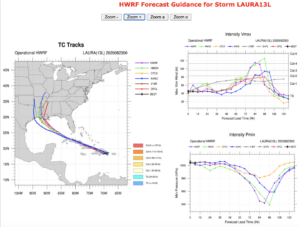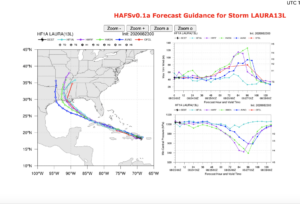-
Laura – another science storm for 2020
Posted on August 23rd, 2020 No commentsThis morning’s NHC forecast calls for Laura to continue tracking from Hispaniola along the spine of Cuba, enter the warm 31C waters of the Gulf and intensify as it moves across the Gulf towards landfall in Louisiana. With the new HWRF v13.0.0 moved to operational status on Aug 5 at 12Z, the focus of our discussions changes. All operational and many experimental models are now using the same ocean, the high quality representation derived from the Navy’s data assimilative GOFS, which is used to initialize the NOAA global RTOFS that layers in the NOAA global winds, which is then used to initialize the ocean models coupled to HWRF, HMON, and FV3 (in HAFS v0.1.a). Lets begin by looking at how this high quality ocean forecast may be influencing the hurricane forecasts.
Yesterday was a remarkable day for Laura hurricane forecasts. We noted there were significant differences in track between the 3 models (HWRF, HMON, and HAFS (v0.1.a)), and that there were significant differences in the resulting intensity as Laura entered the warm Gulf. HWRF took a more easterly track that resulted a rapid intensification to Cat4, HMON and HAFS tracked more towards Texas and was forecast to stay near or below Cat1. But how much of the difference in intensity forecast is due to the different atmospheric models, and how much is due to the different atmospheric and ocean conditions encountered along the different tracks. It is hard to separate the two. You either want the same model along two different tracks to look at the influence of track differences, or different models along the same track to look at model differences.
That makes today’s forecasts for Laura an even more remarkable day for hurricane science. Below are the forecast model results from the NOAA NWS HWRF website. Here on the left we see the HWRF (purple) and HMON (green) forecasts follow almost the exact same track into Louisiana until just before landfall. On the upper right, we see the intensity forecasts. Both HWRF (purple) and HMON (green) are predicting the rapid intensification event at the exact same time, 72 hours into the forecast. Both have it rapidly intensifying to Cat 4. Different models, same track, same ocean, same intensity forecast.

Now lets check in on one of the experimental models in HAFS, specifically version 0.1.a that is coupled to the same ocean as HWRF and HMON. Below on the left, HAFS in light blue is also crossing the Gulf on essentially the same route as HWRF and HMON, also landfalling in Louisiana, but a bit west of the others. But HAFS keeps Laura below hurricane strength the entire time.

This example illustrates the challenges of hurricane forecasting. We are 4 days before the forecast landfall in Louisiana, and with Laura, we see the models converging on a similar solution for track, but still diverging on the solution for intensity. We see that for Laura, the different HWRF and HMON models, now using the same ocean since Aug 5, converge to the same intensity forecast once the track converges. This was not the case as recently as Isaias, the storm just before Aug 5 when HMON used the high quality ocean derived from the Navy’s data assimilative GOFS, and HWRF was still using climatology.
We are learning much from this hurricane season. We are seeing improvements along the entire value chain, from the observing systems we deploy, to our ability to assimilate the data, and on to the coupled atmosphere-ocean models used for the hurricane models. And we are seeing what the NWS annual reviews have been saying for years, that we continue to make progress on track forecasts, but that improvements to intensity forecasts lag. We desperately need the research to figure out why. We have a vast pool of researchers at NOAA, the Navy, in universities and in industry that are willing to contribute, and we have the regional expertise already assembled and coordinated through U.S. IOOS and the OAR Cooperative Institutes. It is time to expand the Hurricane Forecast Improvement Program (HFIP) across agencies, across sectors, and across disciplines. If the answer is HFIP is already doing this, my question will be the same as it has been since Sandy, are we doing enough?
Last 5 posts by Scott Glenn
- Early Season in the Mid Atlantic - June 17th, 2021
- Disturbance in the Gulf - June 16th, 2021
- Hurricane Gliders 2021 - May 3rd, 2021
- Hurricane Iota - November 16th, 2020
- Hurricane Eta - Low Wind Shear, High SST - November 2nd, 2020



